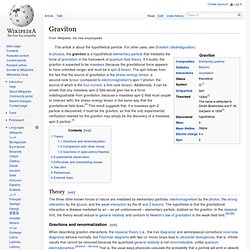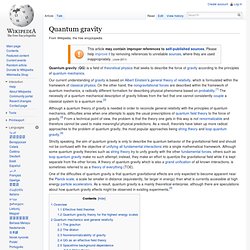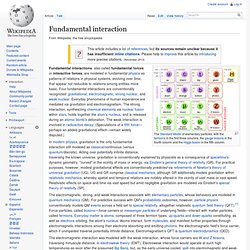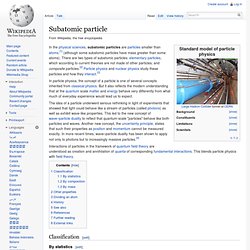

Strange matter. Strange matter is a particular form of quark matter, usually thought of as a "liquid" of up, down, and strange quarks.

It is to be contrasted with nuclear matter, which is a liquid of neutrons and protons (which themselves are built out of up and down quarks), and with non-strange quark matter, which is a quark liquid containing only up and down quarks. At high enough density, strange matter is expected to be color superconducting. Strange matter is hypothesized to occur in the core of neutron stars, or, more speculatively, as isolated droplets that may vary in size from femtometers (strangelets) to kilometers (quark stars). Graviton. Theory[edit] The three other known forces of nature are mediated by elementary particles: electromagnetism by the photon, the strong interaction by the gluons, and the weak interaction by the W and Z bosons.

The hypothesis is that the gravitational interaction is likewise mediated by an – as yet undiscovered – elementary particle, dubbed as the graviton. In the classical limit, the theory would reduce to general relativity and conform to Newton's law of gravitation in the weak-field limit.[6][7][8] Quantum gravity. Quantum gravity (QG) is a field of theoretical physics that seeks to describe the force of gravity according to the principles of quantum mechanics.

Although a quantum theory of gravity is needed in order to reconcile general relativity with the principles of quantum mechanics, difficulties arise when one attempts to apply the usual prescriptions of quantum field theory to the force of gravity.[3] From a technical point of view, the problem is that the theory one gets in this way is not renormalizable and therefore cannot be used to make meaningful physical predictions. As a result, theorists have taken up more radical approaches to the problem of quantum gravity, the most popular approaches being string theory and loop quantum gravity.[4] Strictly speaking, the aim of quantum gravity is only to describe the quantum behavior of the gravitational field and should not be confused with the objective of unifying all fundamental interactions into a single mathematical framework.
800px-Particle_overview.svg.png (800×464) 556px-Standard_Model_of_Elementary_Particles.svg.png (556×599) Color confinement. The color force favors confinement because at a certain range it is more energetically favorable to create a quark-antiquark pair than to continue to elongate the color flux tube.

This is analoguous to the behavior of an elongated rubber-band. An animation of color confinement. Energy is supplied to the quarks, and the gluon tube elongates until it reaches a point where it "snaps" and forms a quark-antiquark pair. Elementary particle. In particle physics, an elementary particle or fundamental particle is a particle whose substructure is unknown, thus it is unknown whether it is composed of other particles.[1] Known elementary particles include the fundamental fermions (quarks, leptons, antiquarks, and antileptons), which generally are "matter particles" and "antimatter particles", as well as the fundamental bosons (gauge bosons and Higgs boson), which generally are "force particles" that mediate interactions among fermions.[1] A particle containing two or more elementary particles is a composite particle.

Everyday matter is composed of atoms, once presumed to be matter's elementary particles—atom meaning "indivisible" in Greek—although the atom's existence remained controversial until about 1910, as some leading physicists regarded molecules as mathematical illusions, and matter as ultimately composed of energy.[1][2] Soon, subatomic constituents of the atom were identified. Overview[edit] Main article: Standard Model. Flavour (particle physics) In particle physics, flavour or flavor refers to a species of an elementary particle.

The Standard Model counts six flavours of quarks and six flavours of leptons. They are conventionally parameterized with flavour quantum numbers that are assigned to all subatomic particles, including composite ones. For hadrons, these quantum numbers depend on the numbers of constituent quarks of each particular flavour. In atomic physics the principal quantum number of an electron specifies the electron shell in which it resides, which determines the energy level of the whole atom.
Fundamental interaction. Fundamental interactions, also called fundamental forces or interactive forces, are modeled in fundamental physics as patterns of relations in physical systems, evolving over time, that appear not reducible to relations among entities more basic.

Four fundamental interactions are conventionally recognized: gravitational, electromagnetic, strong nuclear, and weak nuclear. Everyday phenomena of human experience are mediated via gravitation and electromagnetism. The strong interaction, synthesizing chemical elements via nuclear fusion within stars, holds together the atom's nucleus, and is released during an atomic bomb's detonation. The weak interaction is involved in radioactive decay. (Speculations of a fifth force—perhaps an added gravitational effect—remain widely disputed.) In modern physics, gravitation is the only fundamental interaction still modeled as classical/continuous (versus quantum/discrete). Overview of the fundamental Interaction[edit] The interactions[edit] Quark. A quark (/ˈkwɔrk/ or /ˈkwɑrk/) is an elementary particle and a fundamental constituent of matter.

Quarks combine to form composite particles called hadrons, the most stable of which are protons and neutrons, the components of atomic nuclei.[1] Due to a phenomenon known as color confinement, quarks are never directly observed or found in isolation; they can be found only within hadrons, such as baryons (of which protons and neutrons are examples), and mesons.[2][3] For this reason, much of what is known about quarks has been drawn from observations of the hadrons themselves. The quark model was independently proposed by physicists Murray Gell-Mann and George Zweig in 1964.[5] Quarks were introduced as parts of an ordering scheme for hadrons, and there was little evidence for their physical existence until deep inelastic scattering experiments at the Stanford Linear Accelerator Center in 1968.[6][7] Accelerator experiments have provided evidence for all six flavors.
Subatomic particle. In the physical sciences, subatomic particles are particles smaller than atoms.[1] (although some subatomic particles have mass greater than some atoms).

There are two types of subatomic particles: elementary particles, which according to current theories are not made of other particles; and composite particles.[2] Particle physics and nuclear physics study these particles and how they interact.[3] In particle physics, the concept of a particle is one of several concepts inherited from classical physics. But it also reflects the modern understanding that at the quantum scale matter and energy behave very differently from what much of everyday experience would lead us to expect.